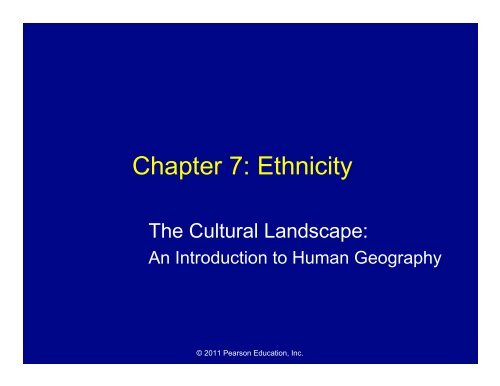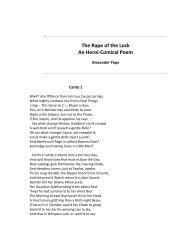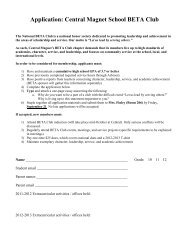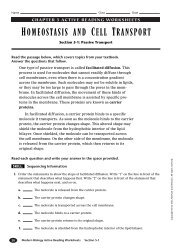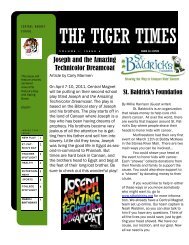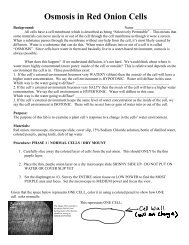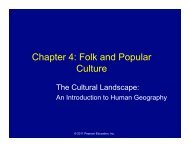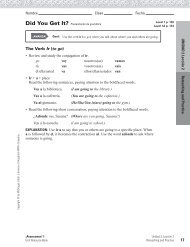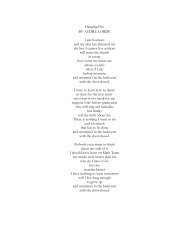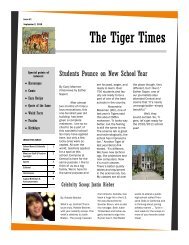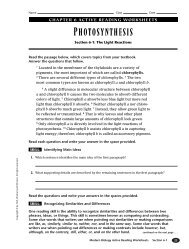Chapter 7 Notes
Chapter 7 Notes
Chapter 7 Notes
You also want an ePaper? Increase the reach of your titles
YUMPU automatically turns print PDFs into web optimized ePapers that Google loves.
<strong>Chapter</strong> 7: Ethnicity<br />
The Cultural Landscape:<br />
An Introduction to Human Geography<br />
© 2011 Pearson Education, Inc.
Ethnicity<br />
• Ethnicity = from the Greek ethnikos,<br />
meaning “national”<br />
– Ethnicities share a cultural identity with<br />
people from the same homeland<br />
– Ethnicities have distinctive cultural traits<br />
• Race = people who share a biological<br />
ancestor<br />
© 2011 Pearson Education, Inc.
Where Are Ethnicities Distributed<br />
• Distribution of ethnicities in the United<br />
States<br />
– Hispanics (Latinos) = 15 percent of the<br />
U.S. population<br />
– African Americans = 13 percent of the U.S.<br />
population<br />
– Asian Americans = 4 percent of the U.S.<br />
population<br />
– American Indians = 1 percent of the U.S.<br />
population<br />
© 2011 Pearson Education, Inc.
Distribution of Hispanics<br />
in the United States<br />
Figure 7-1<br />
© 2011 Pearson Education, Inc.
Distribution of African Americans<br />
in the United States<br />
Figure 7-2<br />
© 2011 Pearson Education, Inc.
Distribution of Asian Americans<br />
in the United States<br />
Figure 7-3<br />
© 2011 Pearson Education, Inc.
Distribution of American Indians<br />
in the United States<br />
Figure 7-4<br />
© 2011 Pearson Education, Inc.
Where Are Ethnicities Distributed<br />
• Concentration of ethnicities in U.S.<br />
cities<br />
– 90 percent of African Americans and<br />
Hispanics live in cities<br />
– Remnants of twentieth-century European<br />
migration = still evident on the landscape<br />
• Example: clustering of restaurants in Little Italy,<br />
Greektown<br />
© 2011 Pearson Education, Inc.
Distribution of Ethnicities in Chicago<br />
and Los Angeles<br />
Figure 7-5 Figure 7-6<br />
© 2011 Pearson Education, Inc.
Where Are Ethnicities Distributed<br />
• African American migration patterns<br />
– Three major migration patterns<br />
• Forced migration from Africa (eighteenth<br />
century)<br />
– The triangular slave trade<br />
• Immigration from the South to northern cities<br />
(first half of the twentieth century)<br />
– Identifiable paths of migration<br />
• Immigration out of inner cities to other urban<br />
areas (second half of the twentieth century to<br />
present)<br />
– The ghetto<br />
© 2011 Pearson Education, Inc.
Triangular Slave Pattern<br />
Figure 7-8<br />
© 2011 Pearson Education, Inc.
African American Migration in the United<br />
States (Twentieth Century)<br />
Figure 7-10<br />
© 2011 Pearson Education, Inc.
Where Are Ethnicities Distributed<br />
• Differentiating ethnicity and race<br />
– Often confusing<br />
– Race = traits that are shared genetically<br />
• Biological features within one racial group are<br />
highly variable<br />
– Biological classification of people into distinct racial<br />
groups is meaningless<br />
• Spatial effects of racism<br />
– “Separate but equal”<br />
– “White flight”<br />
» Blockbusting<br />
– Apartheid in South Africa<br />
© 2011 Pearson Education, Inc.
Apartheid<br />
Figure 7-13<br />
© 2011 Pearson Education, Inc.
Why Have Ethnicities Been<br />
Transformed into Nationalities<br />
• Rise of nationalities<br />
– Nationality = identity with a group of people<br />
who share a common allegiance to a<br />
particular country<br />
– Nation-state<br />
– Examples<br />
• Denmark<br />
• Nation-states in Europe<br />
– Nationalism = loyalty and devotion to a<br />
nationality<br />
© 2011 Pearson Education, Inc.
Nation-states in Europe<br />
Figure 7-15<br />
© 2011 Pearson Education, Inc.
Why Have Ethnicities Been<br />
Transformed into Nationalities<br />
• Multinational states<br />
– Multiethnic state<br />
• A state with multiple ethnic groups, all of whom<br />
might contribute to a larger national identity<br />
– Example: the United States<br />
– Multinational state<br />
• A state with multiple ethnic groups who retain<br />
their own distinctive national identity<br />
– Example: the United Kingdom<br />
– Example: Russia (the largest multinational state)<br />
• Revival of ethnic identity<br />
© 2011 Pearson Education, Inc.
Ethnicities in Russia<br />
Figure 7-18<br />
© 2011 Pearson Education, Inc.
Why Do Ethnicities Clash<br />
• Ethnic competition to dominate<br />
nationality<br />
– Ethnic competition in the Horn of Africa<br />
• Ethiopia and Eritrea<br />
• Sudan<br />
• Somalia<br />
– Ethnic competition in Lebanon<br />
• Religious and ethnic differences<br />
© 2011 Pearson Education, Inc.
Ethnic Diversity in Eastern Africa<br />
Figure 7-21<br />
© 2011 Pearson Education, Inc.
Ethnicities in Lebanon<br />
Figure 7-23<br />
© 2011 Pearson Education, Inc.
Why Do Ethnicities Clash<br />
• Dividing ethnicities among more than<br />
one state<br />
– Dividing ethnicities in South Asia<br />
• India and Pakistan<br />
– Kashmir<br />
• Sinhalese and Tamils in Sri Lanka<br />
© 2011 Pearson Education, Inc.
Ethnic Division in South Asia<br />
Figure 7-24<br />
© 2011 Pearson Education, Inc.
What Is Ethnic Cleansing<br />
• Ethnic cleansing = process in which a<br />
more powerful ethnic group forcibly<br />
removes a less powerful group from<br />
their territory<br />
– The purpose is not to subjugate, but to<br />
remove<br />
– Today, most ethnic cleansing happens in<br />
Europe and Africa<br />
© 2011 Pearson Education, Inc.
What Is Ethnic Cleansing<br />
• Ethnic cleansing in Europe<br />
– Largest forced migration = 1939–1945<br />
• Jews, gypsies, and others forcibly removed by<br />
Nazis<br />
– The former Yugoslavia<br />
• Creation of multiethnic Yugoslavia<br />
• The breakup of Yugoslavia<br />
– Ethnic cleansing in Bosnia<br />
– Ethnic cleansing in Kosovo<br />
– Balkanization<br />
© 2011 Pearson Education, Inc.
The Balkans in 1914<br />
Figure 7-29<br />
© 2011 Pearson Education, Inc.
What Is Ethnic Cleansing<br />
• Ethnic cleansing in central Africa<br />
– Most boundaries in Africa do not<br />
correspond to ethnic groups<br />
– Conflict between Hutu and Tutsi<br />
destabilizes the region<br />
• Ethnic cleansing and genocide in Rwanda<br />
• Refugees spill into neighboring countries<br />
• Democratic Republic of Congo falls into civil<br />
war<br />
© 2011 Pearson Education, Inc.
Ethnicities in Africa<br />
Figure 7-33<br />
© 2011 Pearson Education, Inc.
The End.<br />
Up next: Political Geography<br />
© 2011 Pearson Education, Inc.


